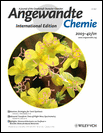Channels and Cavities Lined with Interlocked Components: Metal-Based Polyrotaxanes That Utilize Pyridinium Axles and Crown Ether Wheels as Ligands†
We thank NSERC of Canada and PRF-ACS for financial support of this research. G.K.H. Shimizu and A. P. Côté of the Department of Chemistry, University of Calgary are thanked for providing the thermogravimetric analysis data.
Graphical Abstract
One- and two-dimensional coordination polymers (see picture) in which the bridging ligands are coated with crown ethers (red) can be prepared by metal–ligand self-assembly. These metal-based polyrotaxanes contain channels and cavities that are lined with mechanically linked molecular components. This structural design has significant potential for tuning the physical properties of internal cavities and the production of materials that contain functional molecular entities that may be addressable or controllable.




